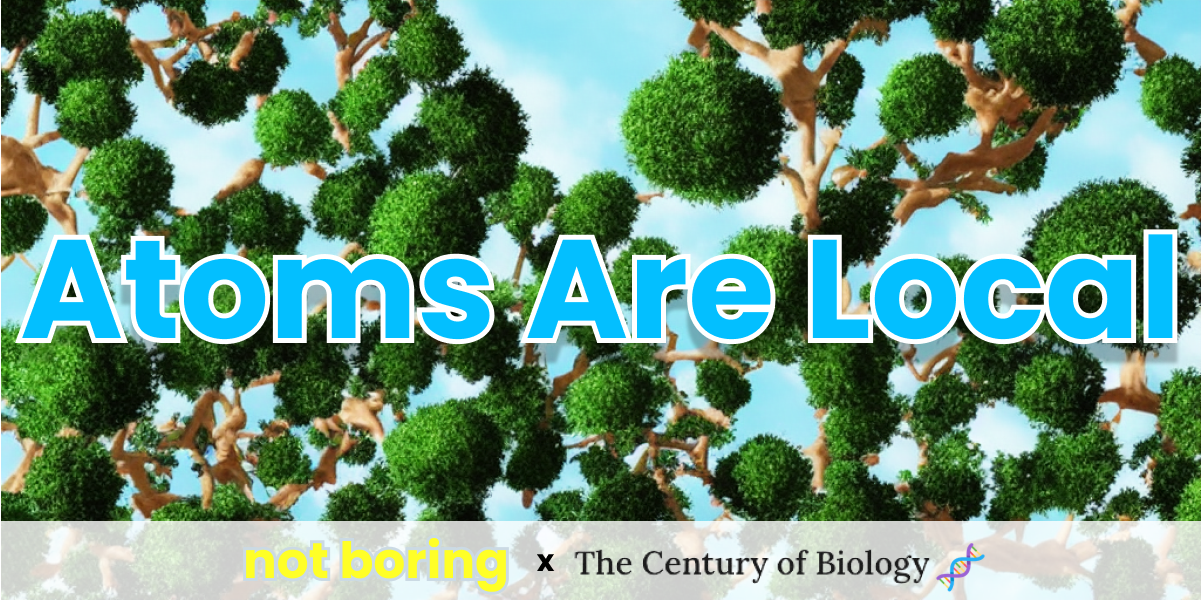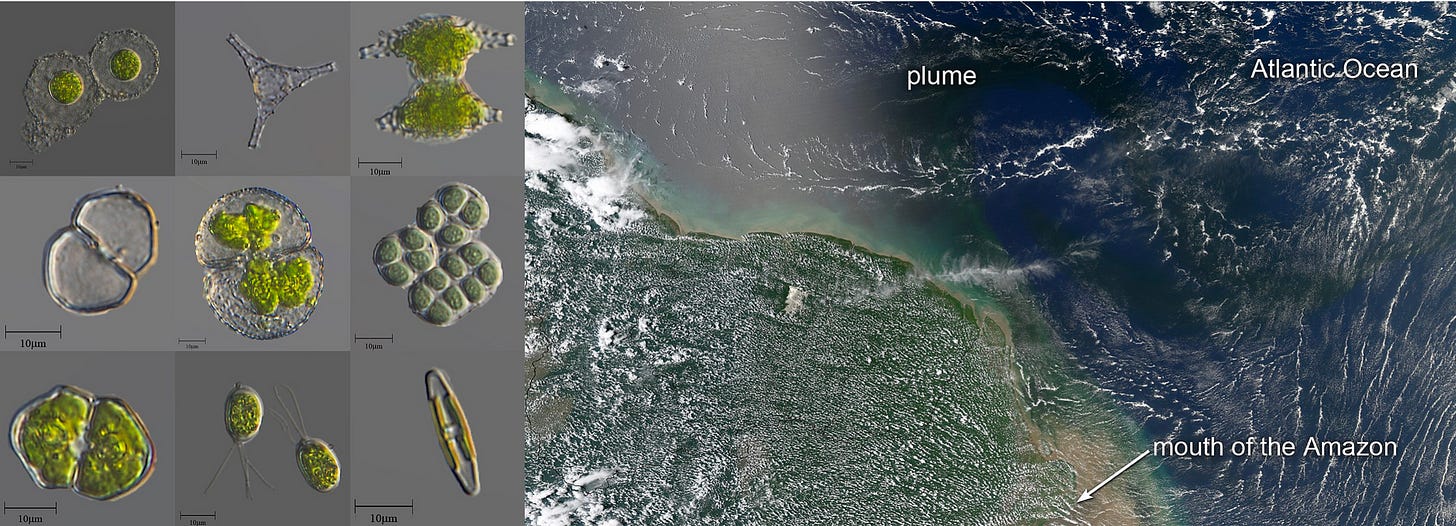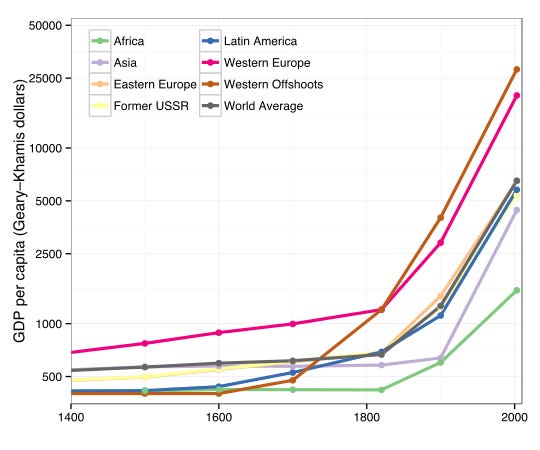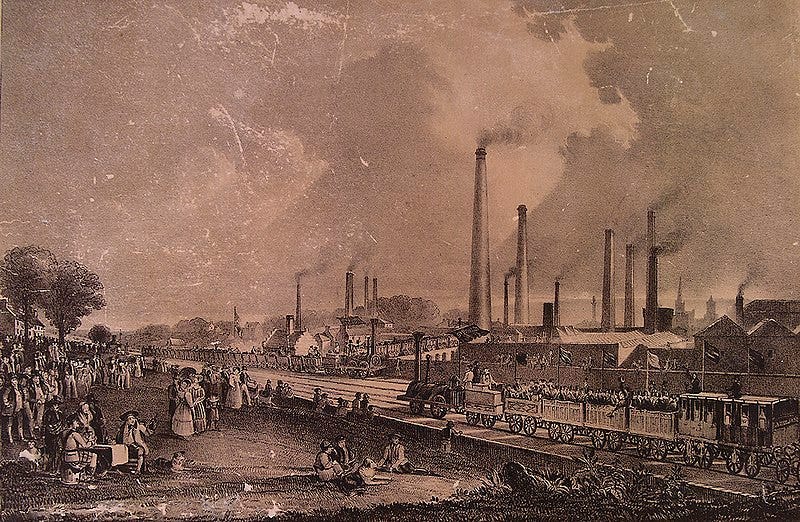Not Boring by Packy McCormick - Atoms Are Local
Welcome to the 2,948 newly Not Boring people who have joined us since last Monday! If you haven’t subscribed, join 165,475 smart, curious folks by subscribing here: Today’s Not Boring is brought to you by… Secureframe Answering RFPs and security questionnaires is critical to closing deals and growing revenue. But the manual process can delay deals or stop them cold. Secureframe helps you respond to both fast with machine learning so you can quickly build trust with customers, close more deals, and accelerate speed to revenue. Click here to schedule a demo of AI-powered Secureframe Questionnaires today. Hi friends 👋 , Happy Monday! Normally, when I write something, no matter how long and complex, I try to get it done in a week. Whenever I try to plan ahead, to write out a list of potential essay topics and start researching weeks in advance, I get bored with them by the time I actually sit down to write the piece. Currently, though, I’m in the middle of researching and writing a piece I’ve been thinking about for weeks and that’s fully captured my imagination. I think it’s going to pull together a lot of the threads we’ve been talking about in Not Boring for the past couple of years and frame the way we look at the world going forward. On Friday, I was trying to jam on that essay to get it done for today, and I realized that if I rushed it out, I was going to fall way short of what I was going for. I panicked a little bit, bummed that I wouldn’t be able to do the idea justice, but marched on. Then, miraculously, two things happened: 1) Anton and I recorded the first episode of a new series, and 2) Elliot sent me a draft of the piece he was working on this week. So instead of a typical Not Boring essay, we’re hitting you with a 1-2 punch. Two geniuses in two of our favorite areas guiding us through their worlds, and two more weeks for me to work on that essay. Anton Teaches Packy AI A couple of weeks ago, I joked on Twitter that I had no idea what I was looking at when I read an AI research paper. Anton Troynikov, the co-founder of Not Boring portfolio company Chroma, replied offering to teach me, paper-by-paper.  @packyM packy i would absolutely do a weekly 'anton explains an ML paper to packy' type thing with you After a little back and forth, we decided that there are probably a lot of people who want to understand what’s going on in AI a lot better than they do, and that we should probably just record our sessions and share them. Anton Teaches Packy AI was born. For the first session, we dug into Attention is All You Need, the 2017 paper that proposed the Transformer architecture at the heart of so much of the innovation happening in AI today. I first read about the paper in Ben Thompson’s excellent interview with Daniel Gross and Nat Friedman and heard about it again in Lex Fridman’s conversation with AI master Andrej Karpathy. It’s a biggie. We decided to make Anton Teaches Packy AI a YouTube series in order to use visual aids to explain the concepts, and I’m excited to unveil our first episode: 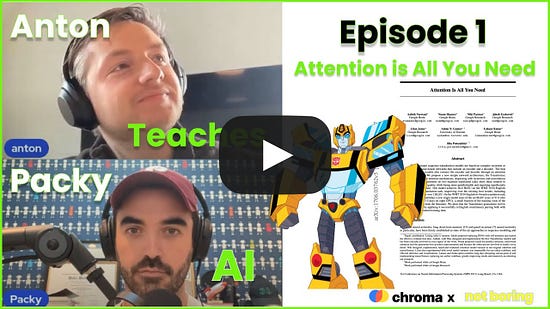 If you’re curious about AI, I’d love if you watched it and SMASH THOSE LIKE, SUBSCRIBE, AND SHARE BUTTONS (am I doing this right? I’m new to YouTube). More importantly, we’d love your feedback. This is very much a work-in-progress, and we want it to be as useful as possible. What can we do better? What questions do you still have about Attention is All You Need? What papers do you want us to do next? We’ll plan to do one of these per week, and I’m happy to serve my ideal role as the kid in class who’s willing to ask the dumb questions no one else wants to ask. 🫡 Atoms Are Local That brings us to the draft of the essay that Elliot sent me. Elliot Hershberg joined Not Boring because he’s my favorite writer on one of the topics that I think will have the most mindblowing impact on humanity in the coming decades but about which I have nowhere near the depth of understanding to write or invest intelligently: biology. One of the things I love about Elliot’s writing is that he combines an academic’s deep grounding in the science with a writer/investor’s willingness to dream up big, crazy ideas. Today’s piece, Atoms Are Local, is a perfect example of that combination. In it, Elliot walks through the science and technology it would take to reach a future in which everything grows on trees. As Elliot writes, “The holy grail of biotechnology is to learn enough of the language of Nature to put an end to disease and human scarcity.” Using technology to put an end to human scarcity is what we’re all about here at Not Boring, so when I read Elliot’s draft, I asked him if we could publish it here, and he agreed. Putting an end to disease and scarcity sounds far-fetched, but Elliot makes a compelling case that we have many of the puzzle pieces we need to make it a reality. In fact, as Elliot and I discuss our potential techbio investments, a risk that keeps popping into my mind is: “Are we going to run out of diseases for these companies to cure?” The ultimate good problem to have. Plus, this piece (along with a couple of Elliot’s other bangers) is going to be an important input to that big one that I’m working on 👀. It’s a key thread in a major trend I’m seeing pop up in places I’d least expect. Let’s get to it. Atoms Are LocalBy Elliot Hershberg We are rapidly pursuing the industrialization of biotech. Large-scale automation now powers complex bio-foundries. Many synthetic biology companies are hellbent on scaling production volumes of new materials. A major concern is the shortage of bioreactors and fermentation capacity. While these all seem like obvious bottlenecks for the Bioeconomy, what if they aren’t? What if there is another way? Here, I’ll explore a different idea: the biologization of industry. Few people have been more effective advocates of engineering biology than Drew Endy. As an early pioneer in the field of synthetic biology, he helped to launch the undergraduate majors in biological engineering at both MIT—which was the first of its kind in the country—and Stanford. His trainees have founded some of the leading companies in the discipline. Clearly, some of his ideas have taken root. However, the concept of the biologization of industry—which I view as one of the most compelling visions for the future of the Bioeconomy—seems to have remained dormant. Here is the core premise:
We exist on a beautiful planet that is completely carpeted in complex living systems. Some of these systems are microscopic in size yet are capable of blooming into populations that are visible from space. Other organisms are insanely large, such as the Armillaria bulbosa fungus that spans at least 15 hectares and weighs more than 20,000 pounds. Biology manages to adapt and grow everywhere and is capable of both atomic precision and enormous scale. In other words, we inhabit a biosphere that is capable of producing more than enough to meet our needs. The holy grail of biotechnology is to learn enough of the language of Nature to put an end to disease and human scarcity. As Ginkgo CEO Jason Kelly puts it:  "X doesn't grow on trees" ... biology is so much better at manufacturing than any human-invented tech that we use it as an idiom for free and abundant. if we all do our job well in synthetic biology everything will grow on trees. So… how do we get to a future where everything grows on trees? At the outset, I’ll admit that this is an enormous question and I don’t have the answer. However, this is precisely the type of question that is worth spending time thinking about, and that can be a generative source of new ideas and directions. In that spirit, we’ll explore:
Let’s jump in! 🧬 The industrialization of biotechThe Industrial Revolution of the 18th and 19th centuries was a major inflection point for our species. Originating in Britain, this revolution laid many of the underpinnings of the modern world that we inhabit. The mechanization of work, the establishment of centralized factories, and the origins of modern capitalism can all be traced back to this tectonic shift. This all turned out to be a pretty big deal: Gross domestic product (GDP) per capita began to skyrocket around the world after centuries of little change. We figured out how to make machines, and even machines that make machines. Early advances included the mechanization of textile production, but it’s hard to think of areas of materials production that haven’t since been industrialized. The industrialization of chemistry proved to be particularly consequential.
Efforts in scaling chemical production and expanding the diversity of molecules that could be produced ultimately led to the establishment of the petrochemical industry. Our world runs on these molecules. Our fuels and energy, clothing, materials and plastics, food (especially from fertilizers), and medicines are all products of modern industrial chemistry. Basically… Better Living Through Chemistry. Despite the increase in production and abundance, industrialization has fundamental shortcomings and many negative externalities. Factories have a human toll. Many industrial methods are highly inefficient and produce enough pollutants to be a threat to planetary health. As we’ve seen during COVID and the Russian invasion of Ukraine, centralized manufacturing and complex global trade routes also introduce fragility into our world. Current industrial production methods can’t be sustainably scaled. The promise of biotechnology is that offers the solution to this problem. So far, we have mainly pursued the industrialization of biotechnology as a way to mitigate the consequences of existing approaches to production. The story of Genentech is an example of this. The first therapeutic produced using genetic engineering—insulin—already existed as a medicine. Before the use of genetic engineering, insulin was isolated and extracted from animals. Genentech’s major breakthrough was to replace highly wasteful and inefficient production methods. The industrialization of recombinant DNA made it possible to harness cells as miniature factories for the production of drugs. Genentech scaled this powerful process in a centralized structure like a pharmaceutical company, and now operates as a subsidiary of Roche. Early examples of consumer products produced using biotech have followed similar storylines. Pat Brown, who was a Stanford professor and inventor of the DNA microarray, founded Impossible Foods to create incredible meat alternatives using genetic engineering. Again, the goal was to mitigate the extreme consequences of industrial farming by producing an equivalent product with far less waste using bioengineering. The result is a new food company with centralized labs and factories that ships these meat alternatives around the world. We are also starting to harness synthetic biology to tackle the issues of industrial chemistry. A Houston-based company called Solugen recently raised over $200 million in a Series D financing to continue growing the operations of their carbon negative molecule factory. This is an incredible example of what the industrialization of biotech can accomplish. Solugen has the potential to scale to profitably and abundantly produce commodity and specialty chemicals while removing CO2 from the atmosphere. So far, the industrialization of biotech has produced powerful replacements for wasteful and inefficient methods of production. We can now generate insulin, and ironically, cheeseburgers, without sacrificing millions of animal lives. Companies like Solugen are demonstrating that we can use biology to build new chemical factories that don’t rely on digging fossils out of the ground. Now, let’s turn our attention to what the biologization of industry might look like. As Endy likes to say, “biology teaches us that atoms are local.” This is a really important idea. Fundamentally, biological systems are built using only the local resources in their environment, and the information in their genomes. Put more simply:
How could we accomplish true local production? A starting point could be antibodies. The Antibody BoxAntibodies are incredible molecular machines. They are large, Y-shaped proteins produced by immune cells to recognize and bind to specific molecules on the surface of pathogens in our bodies. When bound, they physically obstruct their target and serve as a signal for the rest of the immune system to respond to the pathogen. To read how The Antibody Box, Personal Biomakers, and The Bionet could lead us to that abundant, disease-free future with local atoms…Thanks to Dan for editing, to Elliot for lending us his brilliance, and to Anton for teaching me AI! If you don’t already, you should really subscribe to Elliot’s newsletter: Century of Biology. That’s all for today. We’ll be back in your inbox on Friday morning with the Weekly Dose of Optimism. Have a great week! Thanks for reading (and watching), Packy If you liked this post from Not Boring by Packy McCormick, why not share it? |
Older messages
Weekly Dose of Optimism #19
Friday, November 4, 2022
Meta's Protein, It's Time to Space, Nuclear Brief, RSV Vaccine, Stripe Layoffs, AI Portraits
Capital & Taste
Monday, October 31, 2022
Meet the Company Formerly Known as Party Round
Weekly Dose of Optimism #18
Friday, October 28, 2022
The Crypto Story, IEA Calling Top, Data Lasers, Schumpeter's Workout Plan, ML-Powered Drug Discovery, Bleeding Edge AI
Formic: Automating Abundance
Monday, October 24, 2022
Why Robots are good, actually, and how Formic is accelerating their adoption
Weekly Dose of Optimism #17
Friday, October 21, 2022
Cancer Vaccines, Super Sponges, Starlink Aviation, Pillars of Creation, Q>1, Lex
You Might Also Like
Discover a preview of the content keeping Digiday+ members ahead
Thursday, February 27, 2025
Digiday+ members have more ways than ever to stay ahead of the news and trends transforming media and marketing. Explore premium content from our editors below, including weekly briefings, research and
See you in Boston?
Thursday, February 27, 2025
...back in person for the first time since 2019! Exploding Topics Logo Presented by: Semrush Logo You follow Exploding Topics because you want to get an edge on your competition. Now take that
Why I'm doubling down on my community in 2025... (free bonus)
Thursday, February 27, 2025
Hi there 2025 is chugging along (it's almost March!) – and there's a ton going on right now. But there's something that hasn't changed. Your agency still needs a constant stream of new
Programmer Weekly - Issue 243
Thursday, February 27, 2025
February 27, 2025 | Read Online Programmer Weekly (Issue 243 February 27 2025) Welcome to issue 243 of Programmer Weekly. Let's get straight to the links this week. Streamline IT management with
🎙️ New Episode of The Dime China Tariffs & The Next Era of Vapes: Impact on Supply Chains & Brands ft. Nick Kovacevich
Thursday, February 27, 2025
Want to be featured on The Dime Podcast? Scroll to the end of this email to find out how. Listen here 🎙️ China Tariffs & The Next Era of Vapes: Impact on Supply Chains & Brands ft. Nick
80% less time on social reporting sound good?
Thursday, February 27, 2025
Get Forrester's Total Economic Impact™ of Sprout. ͏ ͏ ͏ ͏ ͏ ͏ ͏ ͏ ͏ ͏ ͏ ͏ ͏ ͏ ͏ ͏ ͏ ͏ ͏ ͏ ͏ ͏ ͏ ͏ ͏ ͏ ͏ ͏ ͏ ͏ ͏ ͏ ͏ ͏ ͏ ͏ ͏ ͏ ͏ ͏ ͏ ͏ ͏ ͏ ͏ ͏ ͏ ͏ ͏ ͏ ͏ ͏ ͏ ͏ ͏ ͏ ͏ ͏ ͏ ͏ ͏ ͏ ͏ ͏ ͏ ͏ ͏ ͏ ͏ ͏ ͏ ͏ ͏ ͏
Social proof in email marketing, National Toast Day, and the art of CTAs
Thursday, February 27, 2025
The latest email resources from the Litmus blog and a few of our favorite things from around the web last week. ͏ ͏ ͏ ͏ ͏ ͏ ͏ ͏ ͏ ͏ ͏ ͏ ͏ ͏ ͏ ͏ ͏ ͏ ͏ ͏ ͏ ͏ ͏ ͏ ͏ ͏ ͏ ͏ ͏ ͏
Python Weekly - Issue 688
Thursday, February 27, 2025
February 27, 2025 | Read Online Python Weekly (Issue 688 February 27 2025) Welcome to issue 688 of Python Weekly. We have a packed issue this week. Enjoy it! The #1 AI Meeting Assistant Summarize 1-
Free download: 5 ways to improve your proposals
Thursday, February 27, 2025
A free resource for you ͏ ͏ ͏ ͏ ͏ ͏ ͏ ͏ ͏ ͏ ͏ ͏ ͏ ͏ ͏ ͏ ͏ ͏ ͏ ͏ ͏ ͏ ͏ ͏ ͏ ͏ ͏ ͏ ͏ ͏ ͏ ͏ ͏ ͏ ͏ ͏ ͏ ͏ ͏ ͏ ͏ ͏ ͏ ͏ ͏ ͏ ͏ ͏ ͏ ͏ ͏ ͏ ͏ ͏ ͏ ͏ ͏ ͏ ͏
From living in a car to $1.4M in 5 months
Thursday, February 27, 2025
I love that you're part of my network. Let's make 2025 epic!! I appreciate you :) Today's hack From living in a car to $1.4M in 5 months Taro Fukuyama and 2 of his friends from Tokyo

